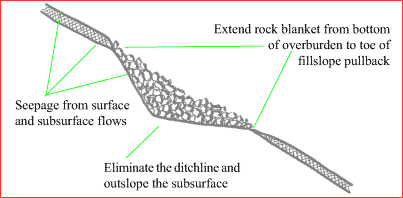|
Forest Road Deactivation Practices
|
|
in the Pacific Northwest
|


|
|
| 14 - Trench Drains
|
Description, Expectations |
Description
Trench drains are drainage structures installed to accommodate seepage zones or small surface flows encountered during deactivation. They
consist of a cross-ditch which is filled with large rock and NOT covered with pulled back material. Trench drains essentially fulfill the
same function as a cross-ditch but make more efficient use of a
stable road bench in heavy pullback areas. They are similar to blanket
drains but the rock is larger and can effectively buttress cutslopes,
and/or support retrieved fill material laterally. Blanket drains,
trench drains, and french drains are all very useful in steep ground
to prevent water accumulations from intercepted flows, and to maintain the natural micro-drainage of the slope.
Figure 9: Trench Drain (Cross-Section)

Expectations
- Material in the trench drain should consist of cobbles and boulders from the surrounding road fill. Use stones 150 mm (6 inches) or larger in diameter. Increase the rock size relative to the size of the surface flows encountered.
- The width of the trench drain depends on the width of the seepage zone, but should be at least 3 meters (10 feet).
- The trench drain extends down the cutslope and across the road bench to the toe of the pulled back road fill.
- The trench drain should have a rock apron to disperse any flows.
- Remove all potentially unstable material downslope from the trench drain outlet.
Figure 10: Trench Drain

|
|
 14 Trench Drains 14 Trench Drains
|
©1999 - 2002 Flip Productions Limited
Used with permission by CulvertBC
|

